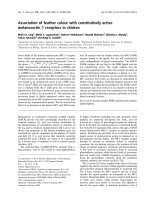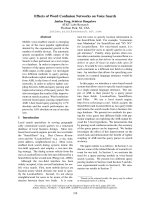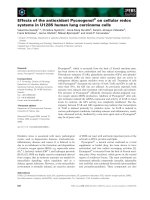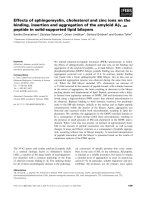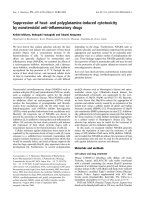Báo cáo khoa học: "Effects of Corticosteroid and Electroacupuncture on Experimental Spinal Cord Injury in Dogs" doc
Bạn đang xem bản rút gọn của tài liệu. Xem và tải ngay bản đầy đủ của tài liệu tại đây (70.49 KB, 5 trang )
J O U R N A L O F
Veterinary
Science
J. Vet. Sci. (2003), 4(1), 97-101
Abstract
15)
The aim of this study is to investigate the effects of
electroacupuncture, corticosteroid, and combination
of two treatments on ambulatory paresis due to
spinal cord injury in dogs by comparing therapeutic
effects of electroacupuncture and corticosteroid.
Spinal cord injury w as induce d in tw enty healthy
dogs (2.5~7 kg and 2~4 years) by foreign body
insertion which compressed about 25% of spinal cord.
There was no conscious proprioception, no extensor
postural thrust, and ambulatory. Dogs w ere divided
into four groups according to the treatment; cor-
ticoste roid (group A), electroacupuncture (group B),
corticosteroid and ele ctroacupuncture (group AB),
and control (group C). Neurological examination was
perform ed everyday to evaluate the spinal cord
dysfunction until motor functions w ere returned to
normal. Somatosensory evoked potentials (SEPs)
w ere m easured for objective and accurate evalu-
ations. The latency in measured potentials w as
converted into the velocity for the evaluation of
spinal cord dysfunctions. Pain perceptions w ere
normal from pre-operation to 5 w eeks after operation.
Recovery days of conscious proprioception in groups
A, B, AB, and C w ere 21.2±8.5 days, 19.8±4.3 days,
8.2±2.6 days, and 46.6±3.7 days, respectively.
Recovery days of extensor postural thrust in group A,
group B, group AB, and group C w ere 12.8±6.8 days,
13.8±4.8 days, 5.4± 1.8 days, and 38.2± 4.2 days,
respectively. There were no significant differences
betw een group A and group B. However, recove ry
days of group AB w as significantly shorter than that
of other groups and that of group C was significantly
*
Corresponding author: Tchi-chou Nam
College of Veterinary Medicine, Seoul National University
San 56-1 Shillim 9-dong, Kwanak-gu, Seoul 151-742, Korea
Tel: +82-2-880-8680; Fax: +82-2-888-5310
E-mail:
This study was supported by Research Institute for Veterinary Science
of Seoul National University.
delayed (p<0.05). Conduction velocities of each group
w ere significantly decreased after induction of spinal
cord injury on SEPs (p<0.05) and they show ed a ten-
dency to return to normal w hen motor functions w ere
recovered. According to these results, it w as consi-
dered that the combination of corticoste roid and
electroacupuncture w as the most therapeutically ef-
fective for ambulatory paresis due to spinal cord
injury in dogs.
Key w ords
: spinal cord injury, electroacupuncture, corti-
costeroid, dog
Introduction
Intervertebral disc disease (IVDD) in dogs is a common
clinical problem encountered in small animal practice.
There are various clinical signs ranging from mild back pain
to paralysis with loss of deep pain perception. Several
methods of managing dogs with IVDD have been reported.
Conservative therapy consists of cage confinement with
medications, physiotherapy, swimming, ultrasound, massa-
ge, eventual antibiotics, laxative diet, and bladder emptying
[10, 12]. Another conservative therapy, as an alternative
medicine, acupuncture is useful in dogs with paresis [15].
Decompressive surgery includes fenestration, dorsal lami-
nectomy, hemilaminectomy and minihemilaminectomy or
pediculectomy [20].
The proper choice of treatment for intervertebral disc
disease remains controversial although there is general
agreement that several forms of decompressive surgery are
most effective for dogs with severe neurological dysfunction
[20]. The approach to an individual case will be influenced
by the stage of the disease [7, 8, 23]. The duration of
clinical signs and economic factors will also influence the
choice of treatment methods [20].
Recovery rate of medications for dogs with ambulatory
paresis is about 90% and recurrence rate is about 28% [9].
But decompressive surgery is the most effective in dogs with
paraplegia [4, 6]. Recovery rate of medications for dogs with
mild paralysis is about 50 ~ 80%, which is significantly
lower than that of paresis [7]. Comparisons or evaluations
Effects of Corticosteroid and Electroacupuncture on Experimental Spinal Cord Injury
in Dogs
Jung-whan Yang, Seong-mok Jeong, Kang-moon Seo and Tchi-chou Nam*
College of Veterinary Medicine, Seoul National University, San 56-1 Shillim 9-dong, Kwanak-gu, Seoul 151-742, Korea
Received December 16, 2002 / Accepted February 2, 2003
98 Jung-whan Yang, Seong-mok Jeong Kang-moon Seo and Tchi-chou Nam
on various decompressive surgeries and medications in dogs
with intervertebral disc disease have been reported [15, 16,
20] but there are few reports on the effects of the combina-
tion of medications and electroacupuncture.
The purpose of this study is to investigate the effects of
electroacupuncture, corticosteroid, and combination of two
treatments on paresis due to spinal cord compression in dogs.
Materials and Methods
Experimental Anim als
Neurologically intact twenty dogs (2.5 ~ 7.0 kg and 2 ~
4 years) were divided into four groups regardless of their
sex, body weight and age. Four groups were corticosteroid
(Group A, n = 5), electroacupuncture (Group B, n = 5),
corticosteroid with electroacupuncture (Group AB, n = 5),
and control (Group C, n = 5).
Induction of Spinal Cord Compression
1. Anesthesia
Dogs were premedicated with acepromazine maleate (0.01
㎎
/
㎏
, IV, Sedaject®, Samwoo, Korea). Ampicillin (20
㎎
/
㎏
,
IM, Penbrex®, Samyang Co., Korea) and enrofloxacin (5
㎎
/
㎏
, SC, Baytril®, Bayer Korea Co., Korea) were admini-
stered. Anesthesia was induced with thiopental sodium (15
㎎
/
㎏
, IV, Penthotal sodium®, Joongwei, Korea). Dogs were
intubated, and the surgical plane of anesthesia was main-
tained using isoflurane (1.5 MAC, Aerane®, Ilsung Co.,
Korea). Lactate Ringer's solution with 5% dextrose (10
㎖
/
㎏
/ h, IV drip, Deahan Hartmandex®, Deahan Pharm. Ltd.
Co., Korea) was administered during the surgical procedure.
2. Induction of spinal cord compression
The skin incision was made at the dorsal midline from
the 2nd to 5th lumbar vertebra and a periosteal elevator
was used to elevate left epaxial muscles from their
attachments on the lateral aspect of spinous processes,
lamina, articular facet and pedicle. Rongeur or pneumatic
bur was used to enter the spinal canal and make the
window of 7×3 ~ 15×5
㎜
on the left lamina according to the
size of spinal canal, cautiously not to contuse the cord.
Epidural fat around the dura mater was removed by
suction. Spinal canal size was examined with blunt micro-
dissector. According to the size of spinal canal, 15×8×3 ~
8×5×2
㎜
size autogenous bone fragment was inserted through
the window to compress spinal cord about 25%. Autogenous
bone fragment was made from a portion of L3 spinous
process. Subcutaneous fat graft was placed over laminectomy
site. Epaxial muscles, subcutaneous and skin were closed
routinely. After recovery from anesthesia, proprioceptive
deficit and loss of voluntary movement were confirmed.
Treatment
1. Medications
In groups A and AB, fourty-eight hours after induction of
spinal cord compression, methyl prednisolone sodium
succinate (MPSS) (30
㎎
/
㎏
, Bando methylprednisolone®,
Bando Pharm. Co. Ltd., Korea) was administrated in-
travenously 6 times, q6h, then prednisolone acetate (PDS) (2
㎎
/
㎏
, Corus prednisolone®, Corus Pharm. Co. Ltd., Korea)
was given orally, bid with cimetidine (10
㎎
/
㎏
, Cimetidine®,
Sungjin Pharm. Co., Korea), misoprostol (5
㎍
/
㎏
, Alsoben®,
Unimed Co., Korea), and vit B1 (1
㎎
/
㎏
, Vitamedin®, Hanil
Pharm. Co., Korea). The dosage of PDS was tapered
according to clinical signs and complications. Cage con-
finement was applied concurrently.
2. Electroacupuncture
In groups B and AB, 48 hours after induction of spinal
cord compression, electroacupuncture treatment was applied
every other day at GV-4 (Ming Men), GV-3 (Yao Yang
Guan), BL-23 (Shen Shu), and BL-24 (Qi Hai Shu) as local
points, and GB-30 (Huan Tiao), GB-34 (Yang Ling Quan),
ST-36 (Zu San Li), ST-40 (Feng Long), ST-41 (Jie Xi) as
distal points. Out of them, at GV-4 (Ming Men) and ST-36
(Zu San Li) electroacupuncture was applied and at other
acupoints traditional acupuncture was used. Electrical
stimulations with 2 V, 25 Hz were done for 20 min by using
of electrical stimulator (Pulse stimulator AM3000, Tokyo
Electronic Co., Japan). Cage confinement was applied
concurrently.
Evaluation
1. Neurological examination
After induction of paresis, all dogs were examined
everyday on motor and sensory functions by postural
reaction, superficial pain and deep pain. These neurological
examinations were continued until the dogs responded
normally.
2. Somatosensory Evoked Potentials (SEPs)
SEPs were measured for prediction of sensory functions.
According to Poncelets method [18], SEPs were represented
as spinal conduction velocity. Stimulation and measurement
were performed with a ‘Neuropack 2, MEM-7102' (Nihon
Kohden, Japan) and subdermal ‘Platinum needle electrodes'
(E2, Grass, U.S.A.) were applied on the two channels. The
channel 1 was located on the subdermal region between the
5th and 6th lumbar vertebra and the channel 2 was
positioned between the 11th and 12th thoracic vertebra.
3. Radiology
Before surgery, plain radiograph was performed to know
the size of spinal canal. According to the radiograph, the
size of bone fragment to insert was determined. After
surgery, myelogram was carried out to confirm that the
spinal cord was compressed by inserted bone fragment.
Statistical Analysis
One-way ANOVA was performed to investigate differ-
Effects of Corticosteroid and Electroacupuncture on Experimental Spinal Cord Injury in Dogs 99
ences among groups in recovery days of conscious pro-
prioception and extensor postural thrust by SPSS (SPSS for
windows Release 8.0 Standard Version, SPSS Ins., USA).
Two-tailed Student's t-test was used to compare conduction
velocities of pre-operation, post-operation and when motor
functions were returned to normal. For statistical interpre-
tation, significance level was set at p
<
0.05.
Results
Mean Recovery D ays of Conscious P roprioception
In group A, mean recovery period of conscious pro-
prioception was 21.2 ± 8.5 days. In group B, 19.8 ± 4.3 days,
in group AB, 8.2 ± 2.6 days, and in group C, 46.6 ± 3.7 days
(Table 1). Mean recovery period of conscious proprioception
was significantly decreased in group AB (p 0.05). How-
ever, there was no significant difference between group A
and group B.
Table 1.
Recovery days of conscious proprioception and
extensor postural thrust in each group
Group
Recovery days*
Conscious proprioception Extensor postural thrust
A
B
AB
C
21.2
±
8.5a
19.8
±
4.3a
8.2
±
2.6b
46.6
±
3.7c
12.8
±
6.8a
13.8
±
4.8a
5.4
±
1.8b
38.2
±
4.2c
* Data are expressed as mean ± SD. aNo significant
difference between groups. bSignificantly shorter than other
groups (p<0.05). cSignificantly longer than other groups
(p<0.05). group A, corticosteroid; group B, acupuncture;
group AB, corticosteroid + acupuncture; group C, control.
Mean Recovery D ays of Extensor Postural Thrust
In group A, mean recovery period of extensor postural
thrust was 12.8 ± 6.8 days, in group B, 13.8 ± 4.8 days, in
group AB, 5.4 ± 1.8 days, and in group C, 38.2 ± 4.2 days
(Table 1). In group AB, mean recovery days of extensor
postural thrust was significantly shorter than those of other
groups (P£¼0.05). Group A and group B had no significant
difference in recovery days.
Table 2.
Changes of conduction velocities between channel 1 to channel 2 in each group
Group
Conduction velocities (m/ sec)*
Pre-operation Post0operation After recovery
A
B
AB
C
56.77
±
8.81
60.13
±
1.43
61.88
±
5.72
70.92
±
4.13
49.73
±
7.36a
46.31
±
8.74a
39.34
±
7.97a
52.59
±
6.20a
54.17
±
7.13
53.22
±
9.44
56.99
±
6.34
67.74
±
5.50
* Data are expressed as mean ± SD. aSignificantly different from pre-operation in each group (p<0.05).
Somatosensory Evoked Potentials (SEPs)
After induction of spinal cord injury, conduction velocities
of each group (Table 2) were significantly decreased
compared with pre-operative value on SEPs (p 0.05).
However, the conduction velocity showed a tendency to
return to normal when motor functions were recovered on
neurological examination.
Radiology
After surgery, myelography was taken. On myelograms,
autogenous bone fragments compressing the spinal cord
about 25%, which were confirmed on the image of
radiopaque extradural mass between L3 and L4.
Discussion
The management of intervertebral disc disease is based
on assessment of the degree of neurological dysfunction and
localization of the lesion. It is now generally accepted that
decompressive surgery is superior to either conservative
management or fenestration, especially for those dogs that
have paresis [20]. However, conservative therapy was effec-
tive as much as decompressive surgery in dogs with am-
bulatory paresis [8]. In this experiment, dogs were induced
to the level of paresis to examine therapeutic effects of
corticosteroid and electroacupuncture.
In 1983, Hoerlein evaluated dexamethasone use in cats
with spinal cord injury and found dexamethasone not to be
more effective than a placebo in improving neurological
outcome [10]. Increasing the dose of dexamethasone to less
than half of the reported equipotent high-dose protocol of
MPSS (30 mg/kg) had resulted in gastrointestinal complica-
tions in dogs and cats [5, 9, 22].
The negative effects of corticosteroid treatment in neu-
rological trauma had been described. It was suggested that
corticosteroids not be used more than 24 hours after onset
of herniation or more than once; their use might cause
additional complications and a slower cure rate [3, 17].
Based on previous study, MPSS was selected first, and then
administered PDS with cimetidine, misoprostol to minimize
complication of corticosteroids.
The mechanism of acupuncture treatment needs more
studies and is not yet understood. However, acupuncture
100 Jung-whan Yang, Seong-mok Jeong Kang-moon Seo and Tchi-chou Nam
was known to be a potent analgesic and thus it might
abolish back pain. Acupuncture could activate axonal
regrowth and thus regeneration of destroyed axons in the
spinal cord. The faster this regrowth took place, the more
axons might gain access to their original distal axonal
sheathes because there was less scar tissue at the lesion.
Acupuncture was a potent antiinflammatory treatment,
because it might decrease local spinal inflammation, edema,
vasodilation or constriction and histamine or kinin release.
This would decrease scar tissue formation, cord compression
or hypoxemia and pain [13].
In this study, acupoints could be divided into local and
distal points. Local points were segmental urinary bladder
points. Local points on the governing vessel meridian in
these segments were also used. The logic of using local
points was that they might have segmental effects at the
site of lesion. The segmental effects were that A-beta fibers
stimulated, rapidly carrying nonpainful sensory information
to the substantia gelatinosa, would synapse on inhibitory
interneurons that would close the “gate” to ascending pain
transmission before pain impulses arrived from slowly
conducting C fibers. This would prevent pain impulses from
reaching higher brain centers for conscious perception [21].
Based on this principle, GV-3, GV-4, BL-23 and BL-24, close
to L3 and L4 vertebra, were used as local points.
Distal points used in this study were on urinary bladder
(BL), gall bladder (GB) and stomach (ST) meridians. The
logic of distant points used was presumed that they
stimulate nerve fibers that have an afferent input on higher
centers and on the injured spinal segment. These impulses
might combat inflammation and pain and activate rege-
neration. Acupuncture with only four needles was proved to
be as effective as a slightly more extensive treatment [15].
In this study, the choice of distal points which were GB-30,
GB-34, ST-36, ST-40, and ST-41 was based on a Rogers'
computerized best point choice listing [13].
Stimulation methods can be divided into five categories;
plain puncturing, electrostimulation of needles, laser the-
rapy, injections at acupoints, and moxibustion [1]. Electro-
stimulation is used more frequently in the United States
than in Europe and China [13]. The electrostimulation is
applied with a wide variety of machines, a wide variety of
waveforms, wave patterns and intervals, different frequen-
cies and amplitudes. The amplitude is augmented until
muscle twitching and pain is observed. In one report,
electrostimulation deteriorated the condition of the patient
and no better results have been reported by using electros-
timulation than by plain acupuncture [14]. However, it was
currently widely used in many human and veterinary
acupuncture practices to treat pain and physical ailments
and to induce analgesia for surgical procedures. Several
advantages of electroacupuncture than traditional acupunc-
ture were savings in time, the amount and quality of
stimulation can be more accurately, uniformly, and objec-
tively regulated and measured, and the electroacupuncture
produce a higher and more continuous level of stimulation
than can be provided manually [1].
In general, weak stimulation with low current and low
frequency applied to an acupuncture point will tonify that
point which procedure is indicated for chronic pain pro-
blems. To accomplish sedation or analgesic, high frequency,
greater than 15 Hz (usually 25 ~ 150 Hz), and higher
amplitude of current are used. This technique is primarily
used for acute pain problems [1].
The recovery days of the dog which had negative res-
ponses on proprioception and hoping were 90% within a
three-week period with electroacupuncture [9]. This was
almost accorded with the result of group A in the present
study.
The availability of objective and accurate methods for
spinal cord function assessment could be of great help [19].
In this experiment, SEPs were measured for more objective
and accurate evaluation of spinal cord dysfunctions. Several
investigators have suggested that ambulation after spinal
injury can be predicted by SEPs [11]. Spinal trauma may
cause the reduction of conduction velocity or amplitude in
spinal cord. Conduction velocities were more often affected,
but were not always reduced in dogs with paralysis.
Conduction velocity might have been more affected by
compression, and amplitude more affected by hypoxia.
However, additional studies were needed to confirm these
hypotheses [2]. In this study, conduction velocities in each
group after induction of spinal cord compression were
significantly decreased compared to those of pre-operation.
In the present study, it was suggested that the com-
bination of corticosteroid with electroacupuncture was
significantly more effective than corticosteroid or electro-
acupuncture alone. It was thought to be due to a synergistic
action of analgesic, antiinflammatory, antiedemic effect of
corticosteroid and acupuncture.
References
1.
Altman, S.
Techniques and instrumentation. Problems
in Vet. Med. 1992,
4
, 66~87. 1.
2.
Andy, S., Richard, W. R. and Charles, D. K.
Spinal-evoked potentials in dogs with acute compressive
thoracolumbar spinal cord disease. Am. J. Vet. Res.
1987,
48
, 1525~1530.
3.
Bellah, D. Jr.
Colonic perforation after corticosteroid
and surgical treatment of intervertebral disc disease in
a dog. J . Am. Vet. Med. Assoc. 1983,
183
, 1002~1003.
4.
Bitetto, W. V. and Brown, N. O.
Selection of the
appropriate surgical approach for intervertebral disc
disease. Problems in Vet. Med. 1989,
1
, 415~433.
5.
Braughler, J. M., Hall, E. D. and Means, E. D.
Evaluation of an intensive methylprednisolone sodium
succinate dosing regimen in experimental spinal cord
injury. J. Neurosurg. 1987,
67
, 102~105.
6.
Braund, K. G.
Disease mechanisms in small animal
surgery, pp 960~970. 2nd ed. Lea & Febiger, Phila-
Effects of Corticosteroid and Electroacupuncture on Experimental Spinal Cord Injury in Dogs 101
delphia, 1993.
7.
Butterworth, S. J. and Denny, H. R.
Follow up
study of 100 cases with thoracolumbar disc protrusions
treated by lateral fenestration. J. Sm. Anim. Prac.
1991,
32
, 443~447.
8.
Davies, J. V. and Sharp, N. J. H.
A comparison of
conservative treatment and fenestration for thoraco-
lumbar intervertebral disc disease in the dog. J. Sm.
Anim. Prac. 1983,
24
, 721~729.
9.
Faden, A. J., Jacobs, T. P. and Patrick, D. H.
Megadose corticosteroid therapy following experimental
traumatic spinal injury. J. Neurosurg. 1984,
60
, 712~717.
10.
Hoerlein, B. F., Redding, R. W., Mcguire, J. A. and
Hoff, E. J.
Evaluation of dexamethasone, DMSO,
mannitol, and solcoseryl in acute spinal cord trauma. J.
Am. Anim. Hosp. Assoc. 1983,
19
, 216~226.
11.
Holliday, R. W., Weldon, N. E. and Ealand, B. G.
Percutaneous recording of evoked spinal cord potentials
of dogs. Am. J. Vet. Res. 1979,
40
, 326~333.
12.
Jadeson, W. J.
Intervertebral disk lesions. J . Am. Vet.
Med. Assoc. 1961,
138
, 411~423.
13.
Janssens, L. A.
Acupuncture for the treatment of
thoracolumbar and cervical disc disease in the dog.
Problems in Vet. Med. 1992,
4
, 107~116.
14.
Janssens, L. A.
Prolapse of thoracolumbar disc: A
contraindication for electroacupuncture in dogs. Am. J.
Acupunct. 1986,
14
, 61~64.
15.
Janssens, L. A. and de Prins, M. E.
Treatment of
thoracolumbar disc disease in dogs by means of
acupuncture: A comparison of two techniques. J. Am.
Anim. Hosp. Assoc. 1989,
25
, 169~174.
16.
McKee, W. M.
A comparison of hemilaminectomy (with
concomitant disc fenestration) and dorsal laminectomy
for the treatment of thoracolumbar disc protrusion in
dogs. Vet. Rec. 1992,
130
, 296~300.
17.
Moore, R. W. and Withrow, S. J.
Gastrointestinal
hemorrhage and pancreatitis associated with interver-
tebral disc disease in the dog. J . Am. Vet. Med. Assoc.
1982,
180
, 1443~1447.
18.
Poncelet, L., Delauche, A. and Vinals, C.
Effect of
bilateral tibial nerve stimulation on the spinal evoked
potential in dogs. Am. J. Vet. Res. 1992,
53
, 1305~1308.
19.
Poncelet, L., Michawx, C. and Balligard, M.
Soma-
tosensory potentials in dogs with naturally acquired
thoracolumbar spinal cord disease. Am. J. Vet. Res.
1993,
54
, 1935~1941.
20.
Scott, H. W.
Hemilaminectomy for the treatment of
thoracolumbar disc disease in the dog: a follow-up study
of 40 cases. J. Sm. Anim. Prac. 1997,
38
, 488~494.
21.
Smith, F. W. K. Jr.
Neurophysiologic basis of acupunc-
ture. Problems in Vet. Med. 1992,
4
, 34~52.
22.
Sorjonen, D. C., Dillon, A. R. and Powers, R. D.
Effects of dexamethasone and surgical hypotension on
the stomach of dogs: clinical, endoscopic and pathologic
evaluations. Am. J. Vet. Res. 1983, 44, 1233~1237.
23.
Wheeler, S. J.
Diagnosis of spinal disease in dogs. J .
Sm. Anim. Prac. 1989,
30
, 81~91.

